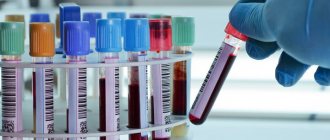What is lymphocytic leukemia?
Lymphocytic leukemia in the modern medical understanding is one of the most common forms of hematological diseases. A fairly typical variation of classical leukemia affects all major structures of the body, including the systemic bloodstream, bone marrow, liver, lymph nodes, and spleen. Moreover, as practice shows, the disease is typical for representatives of the Caucasian race and is rarely found in African and Asian countries.
The main risk group in the presence of lymphocytic leukemia includes elderly people, while men get sick 2 times more often than the fair sex.
As modern research shows, the main predisposition to the development of diseases is inherited: the risk of developing an oncological process in direct relatives is on average 8 times higher than in people who are not related.
Indications for testing for lymphocytic leukemia and symptoms of the disease
The primary diagnostic method that suggests the presence of chronic forms of lymphocytic leukemia in a person is a standard blood test. If there is a suspicion, it is supplemented by immunophenotyping, cytogenetic studies, physical examination, a test for hemolytic anemia, and in some cases, a bone marrow biopsy.
The main indications for analysis are the presence of characteristic manifestations of pathology at any stage. At the same time, in the early stages of the development of the disease, the symptoms are not specific; quite often the problem is detected only as part of a regular therapeutic examination with appropriate tests.
Basic clinical manifestations include:
- Visual increase in the size of the lymph nodes, spleen and liver in the middle and late stages of oncology;
- Secondary external signs. In particular, these are increased fatigue, weakness, apathy, a significant decrease in working capacity, regular profuse night sweats, chills, causeless sharp fluctuations in body weight, as well as a constant slight increase in body temperature;
- Complex pathologies diagnosed laboratory and instrumentally, including absolute lymphocytosis, generalized forms of lymphadenopathy, thrombocytopenia, anemia, neutropenia, including autoimmune nature;
- Systemic immunosuppression , expressed in a partial decrease or almost complete disappearance of humoral immunity and a strong predisposition to all types of infectious lesions. In addition, the likelihood of allergic and autoimmune responses to a wide range of different irritants increases tenfold.
Brief information about the disease
Medical science has not yet fully determined the exact causes of the disease. The main factor is considered to be the influence of unfavorable heredity, expressed in the transmission of damaged genes to subsequent generations. Lymphocytic leukemia is characterized by hyperplasia (proliferation) of the lymphatic tissues of the organs of hematopoiesis (formation and maturation of blood cells), including bone marrow, lymph nodes, spleen, etc.
The progression of hyperplasia is associated with the uncontrolled abnormal division of immature defective lymphocytes. Atypical lymphocytes do not have the properties of full-fledged blood cells, but at the same time, they multiply forcibly, displace and destroy healthy blood cells and fill the circulatory system.
Reference! Lymphoid tissue includes lymphocytes - colorless blood cells that are part of agranulocytes (a subgroup of leukocytes), and macrophages - cells for capturing and neutralizing agents that threaten the body.
The main lymphocytic function of lymphocytes is to provide an immune response (humoral immunity) to the invasion of pathogens and inhibit the activity of cancerous and mutating cells of the body's own. Lymphocytosis - an increase in the concentration of lymphocytes is a clinical sign of impaired immune defense.
Blood disease has two forms:
- acute – accumulation of blasts (immature lymphocytes) in the bone marrow and bloodstream;
- chronic - accumulation of mature but incompetent blood cells in the lymph nodes, peripheral blood and bone marrow.
ALL (acute lymphocytic leukemia) is most often diagnosed in preschool children. The chronic form is typical for adults aged 50+, with a predominance in men. CLL (chronic lymphocytic leukemia) develops in three stages:
- initial (initial), or asymptomatic (damage to 1-2 areas of the body);
- progressive, with the development of detailed manifestations (3 or more areas are involved in the process);
- terminal or final (large-scale damage to the lymphatic system).
The disease is considered irreversible. It is impossible to stop the destructive processes of the circulatory system and reverse them. Diagnosis of CLL includes a number of laboratory tests, molecular biological, immunochemical studies, and specific microscopy of oncohematological diseases.
Decoding the results
As mentioned above, the basic method for the initial detection of potential pathology is a general blood test with a leukocyte formula. The main interpretation of the results in the presence of lymphocytic leukemia:
- Leukocytes. In the initial form of the pathology, lymphoblasts are present in the blood. In the case of chronic forms of lymphocytic leukemia, such blood test indicators as lymphoblasts are no longer present, however, remains of destroyed lymphocytes are found in the blood smear, and in excess quantities;
- Platelets. In the vast majority of cases, they are reduced in the middle and late stages of pathology;
- Red blood cells and hemoglobin. Most often below normal in the later stages of the pathological process.
Decreased lymphocyte levels in blood tests
Lymphopenia is a decrease in the number of lymphocytes in the blood (less than 1.5 * 109 cells per liter).
If lymphocytosis is considered a normal immune response to foreign agents, then lymphopenia is an inadequate response to changes in the body, which indicates a malfunction in the immune system.
The main reasons for the decrease in lymphocytes:
- severe debilitating viral infections;
- immunodeficiency conditions (HIV, AIDS);
- aplastic anemia (suppression of hematopoiesis in the bone marrow);
- oncological diseases (lymphogranulomatosis);
- long-term use of corticosteroids;
- radiation therapy, chemotherapy.
Of course, it is impossible to make a final diagnosis based only on changes in the number of lymphocytes. Deviation from the norm may indicate both mild viral infections and severe malignant processes, which is why this indicator in the general analysis is very valuable in the early diagnosis of blood cancer. Therefore, if there is any change in the number, you should immediately consult a doctor and conduct additional research.
Source: krasnayakrov.ru
Stages of disease development and diagnostic methods
In modern medical diagnostic practice, a three-level staging system for lymphocytic leukemia is used, modified to reduce the potential number of risk groups. Moreover, they correspond to the data of physical examination and the results of laboratory tests with a natural reflection of the course of the pathology, expressed in the gradual accumulation of tumor mass. This gradation makes it possible to make medium-term predictions of the potential survival of patients.
It should be understood that it is quite difficult to predict long-term individual risks using laboratory tests, so special markers are used as a supplement using complex secondary diagnostic methods.
In general, lymphocytic leukemia is divided into the following stages:
- First degree. Expressed exclusively by lymphocytosis. Has a degree of distribution of less than three areas, while platelet and hemoglobin levels are normal;
- Second degree. It is characterized by the presence of lymphocytosis in a progressive stage, as well as slight or moderate enlargement of the lymph nodes, spleen and liver. Pathology covers more than three areas. Hemoglobin levels remain normal, but platelets may be low compared to normal;
- Third degree. It is expressed in a severe form of lymphocytosis, a significant enlargement of the liver, spleen, and lymph nodes. In addition, there is a widespread distribution of the pathological process, thrombocytopenia and anemia, expressed accordingly by a significant drop in platelet and hemoglobin levels below normal.
In addition to the classic blood test, additional diagnostic methods include the following:
- Immunophenotyping. It is a mandatory procedure to confirm the diagnosis of the underlying disease. As part of the study, an absolute search for aberrant immunophenotypes is carried out as part of the study of biomaterial from peripheral blood. In addition to it, the presence of pathological clonality, membrane-bound immunoglobulins is monitored, and biopsy samples in the spleen and lymph nodes are analyzed;
- Cytogenetic study. In modern diagnostic practice, standard karyotyping and fluorescent hybridization are carried out. The purpose of the procedure is to search for chromosomal mutations with high prognostic significance. In each of the patients with one or another form of lymphocytic leukemia, several standard mutations of individual genes can be detected;
- Physical examination. Gives general clinical dynamics based on the systemic nature of the development of leukemia. In addition to it, computed tomography, ultrasound and MRI are carried out, mainly in relation to the current condition of the lymph nodes, spleen and other organs that may require additional targeted treatment;
- Test for hemolytic anemia. It is carried out when the risk of developing autoimmune complications increases or there are no obvious clinical manifestations of the underlying pathology. In general, it is implemented by determining the levels of bilirubin fractions, counting the number of reticulocytes and direct Coombs test;
- Bone marrow biopsy. In the vast majority of cases, it is not performed in the treatment of lymphocytic leukemia, but is prescribed if it is necessary to secondary identify the causes of cytopenia by examining myelograms based on the results of monitoring the parameters of bone marrow aspirate or punctate.
Consequences and complications
Complications are divided into autoimmune and infectious. Both the first and second can develop in any period of the disease. Autoimmune diseases include:
- Autoimmune hemolytic anemia . Sometimes it is the earliest symptom and appears long before other signs. But still, it often develops with a pronounced clinical and hematological picture of the disease.
- Autoimmune thrombocytopenia (synonymous with idiopathic thrombocytopenic purpura ). Occurs in 3% of patients. Characterized by a rapid decrease in platelets (30×109/l). If the platelet count decreases rapidly along with the development of anemia, then thrombocytopenia is most likely autoimmune in nature. Signs of hemorrhagic diathesis appear: skin bruises, nosebleeds and bleeding from the gums. The greatest danger is cerebral hemorrhages, which cause death.
- Partial red cell aplasia . Characterized by severe anemia. The problem of infectious complications is crucial for the course and outcome of chronic lymphocytic leukemia. Infectious complications occur at any stage of the disease and occur in 75-80% of patients. In most patients they cause death. Doctors often encounter infectious complications in patients with severe manifestations of the underlying disease. It is not uncommon to have 2-3 infectious foci. Treatment of infectious complications in these patients is very difficult.
The most common infectious complications are:
- Respiratory tract diseases: pneumonia , tracheitis , bronchitis , pleurisy . Some patients have pneumonia twice a year and are severe.
- Suppurative skin lesions - erysipelas , furunculosis , pyoderma . If infectious foci are not quickly eliminated, the process often spreads. An abscess occurs at the injection site, then the lymph node suppurates, then an abscess of the subcutaneous tissue appears, septicopyemia and severe pneumonia .
- Herpes zoster . The course of this viral disease is very severe. It begins with an increase in temperature and the appearance of severe pain in the chest or limbs. Then skin elements (vesicles) appear in these places, and in some patients, on the face. Multiple blisters can completely cover the skin of the trunk, face and limbs. Some patients have a bullous form, when the size of the blisters reaches 15-20 cm.
- Urinary tract infection ( cystitis , pyelonephritis ).
Acute and chronic lymphocytic leukemia
Acute and chronic forms of lymphocytic leukemia differ significantly from each other, while the true form of the underlying pathology is the second.
The fundamental differences lie in the clear differentiation of cell modifications of tumor structures. The early stages of the formation of lymphocytic leukemia are characterized by a significant accumulation of immature cells and the lack of their growth: the components inhibit the full hematopoiesis of new shoots.
In turn, chronic forms of lymphocytic leukemia are characterized by structural changes and processes of pathological restructuring of granulocytes (including deletion, inversion, fragmentation and translocation) with the gradual replacement of healthy cells in the systemic circulation.
Acute and chronic forms of lymphocytic leukemia never transform into each other and are relative, used solely for convenience as part of basic diagnostic measures.
Acute lymphocytic leukemia can be correlated with classical leukemia, which includes periods of exacerbation and remission and the possibility of complete recovery of the patient or transition of his pathology to the terminal stage. In turn, the chronic type of the disease is de facto incurable, especially considering that it develops mainly in older people, some of whom, due to the slow progression of the pathological process, die their own natural death.
Stages of lymphocytic leukemia
As mentioned above, early lymphocytic leukemia was divided into 5 stages. In recent decades, such an outdated scheme has been modified to optimize the identification of key risk groups and universalize standard treatment protocols. The modern interpretation postulates 3 basic stages of pathology staging:
- Stage A. It is manifested exclusively by lymphocytosis, has an insignificant prevalence, while other test parameters remain normal. It is considered a zero or pre-leukemic state, which over time can develop into a full-fledged disease;
- Stage B. Characterized by the presence of persistent lymphostasis, slight enlargement of the lymph nodes, sometimes the spleen and liver. The pathology affects at least three areas according to the degree of distribution, however, most parameters of general tests, in addition to lymphocytes and platelets, are still normal;
- Stage C. Manifested by the presence of a severe form of lymphocytosis with a parallel significant enlargement of the liver, spleen, and lymph nodes on a permanent basis. In this case, platelet and hemoglobin levels are much lower than normal, cytogenetic characteristics deteriorate significantly, malignant clones appear, the concentrations of which increase linearly.
Non-Hodgkin's lymphomas
This fairly large group included all types of lymphomas that cannot be classified as Hodgkin lymphoma.
In medical usage, the first word is usually omitted, and doctors simply call the disease “lymphoma.” What is the difference between these two groups of diseases?
Only the presence of Berezovsky-Sternberg-Reed cells, which are considered specific for Hodgkin lymphoma.
In each case when these cells are not detected, the doctor diagnoses non-Hodgkin's lymphoma.
However, the diagnosis does not end there, since non-Hodgkin lymphomas are very different diseases with different symptoms, course, histology and, accordingly, treatment and prognosis.
READ Established norm of red blood cells in the blood of men
Indolent lymphomas develop slowly and respond well to treatment.
Symptoms of aggressive forms are much more varied and require immediate treatment. There are also diseases with intermediate characteristics.
Video:
Cytological examination largely determines the future fate of the patient, since it shows the degree of differentiation of tumor cells.
The more differentiated they are, the closer to normal and, therefore, the better the prognosis. Cytology also studies the growth of a tumor inside the affected lymph node.
Another type of non-Hodgkin lymphoma is called extranodal. Their diagnosis is complicated by the fact that the lymph nodes do not enlarge, since the disease does not occur in the lymphatic system, but in various other organs.
The prognosis and treatment protocol depend on two important criteria determined by the diagnosis:
- Form of the disease;
- Stage, that is, the degree of spread of the process throughout the body. Non-Hodgkin's lymphomas have the same four stages as granulomatosis.
The combination of these data will also affect the intensity and duration of treatment.
What therapy is used for this disease?
As mentioned above, lymphocytic leukemia in the vast majority of cases in elderly patients is a practically incurable and slowly progressive disease. However, treatment is not started immediately after the pathology is identified, especially in situations where the pathology remains stable.
When the progression of the pathological process is activated, leading to a significant deterioration in the patient’s medical condition and quality of life, standard chemotherapy protocols are used, including the complex use of alkylating drugs, nucleotide analogues and monoclonal antibodies.
Due to the fact that lymphocytic leukemia has a systemic course, radiotherapy for its chronic forms is not used due to ineffectiveness.
Typical primary treatment regimen
The most typical and fairly effective regimen, which allows 80 percent of cases to achieve remission after initial use, is the use of a combination of rituximab, cyclophosphamide and fludarabine. Bendamustine is used as an alternative or adjunct to this practice.
As practice shows, a number of patients with active progression of the pathological process exhibit resistance to cytostatics. In this situation, the only effective method of reducing the risk of developing the terminal stage in the shortest possible time is allogeneic bone marrow transplantation. Maintenance treatment includes high doses of glucocorticosteroids and monoclonal antibodies such as alemtuzumab.
It is worth noting that regular intensive chemotherapy for people over 50 years of age is significantly hampered by the extremely poor somatic status of patients and the presence of a number of chronic diseases.
Therapy for relapses
In case of relapse of lymphocytic leukemia, the main direction of treatment is the use of targeted drugs based on tyrosine kinase inhibitors, as well as other highly selective analogues.
The new generation of experimental drugs, which are a separate class of antitumor immunomodulators with targeted effects, are currently not used in clinical practice, as they are in the final stages of testing.
Prognosis for illness
It should be understood that true type lymphocytic leukemia is a virtually incurable disease due to a number of special circumstances determined by the specific risk groups of patients (manifests mainly in the elderly) and the inability to use separate, sufficiently effective methods to counteract the development of the oncological process in their regard.
However, it is worth considering that lymphocytic leukemia itself is a fairly heterogeneous disease. The pathology can proceed for a long time and without much progression, or, on the contrary, it can be extremely aggressive.
As medical statistics show, in 1/3 of cases a patient with lymphocytic leukemia dies for reasons unrelated to the underlying disease. Moreover, in 15 percent of people, death occurs within 2, maximum 3 years from the moment of diagnosis.
Approximately half of all patients have an average survival time of 5 to 10 years, after which end-stage disease and death occur.









